


Jade Jewelry
If you have any suggestions for future newsletters, please let me know at suggestions@mrbead.com.† You have been sent this newsletter because you opted to receive occasional mail from us during a past purchase, but should you wish to be taken off the mailing list, just click the link at the bottom.† This monthís theme is Jade Jewelry.† Scroll down, or click one of the links on the html version to go to a certain section. For this month's special offer scroll down or click here
Buying Jade for Jewelry
Knotting a Jade Necklace
How to make a simple Jade Bracelet
History of Jane
Types of Jade
Where Does Jade Come From
Quality of Jade
Buying Jade for Jewelry
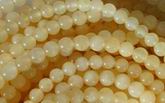
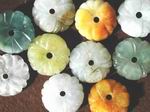
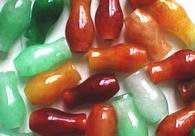
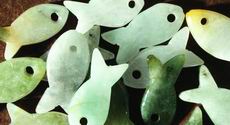
To make jewelry, jade is available in loose beads and temporarily
strung into strands.† Loose beads are
cheaper, but beads on strands will hang better making them best for necklaces.† However, if you plan on knotting your
necklace, then loose beads may be all right.†
Usually each strand, or string in the
Knotting a Jade Necklace

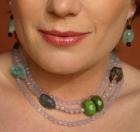
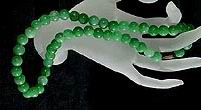
Many of your finer beaded
jewelry is knotted because knots keep the beads from rubbing against each other
- and if the necklace breaks, beads wonít go flying. Knotting also makes the
necklace drape nicely and adds length so you need less beads. †
There are a few ways to knot a necklace, but this the
easiest for beginners. First, youíll need to choose your cord - usually between
silk and nylon. †Silk is traditional,
however many complain that it snags and frays. Both come in a variety of
colors. They can be purchased on small cards with about 6 feet of cord and a
needle attached or, for the serious knotter, larger spools can be purchased
with separate needles. They also come in different sizes. The thicker cord is
used for the larger beads since the holes in the beads are larger. For the
beginnerís technique, two strands are put through each bead, so a thinner size
is needed. For 6mm beads, use size 2 for this technique, and try to match the
color of the cord with the color of the beads.
A very-popular way to start any beaded necklace is with bead tips (clamp shells). The only difference here is that two strands of the cord are inserted through the bead tip instead of one.† Once the necklace is started, string on a bead, and make an over hand knot. Make the knot tight so itís snug up against the bead.† Continue to do this: string a bead, make an over hand knot, string a bead, make an over hand knot. Thatís it.† Finish the necklace as you would any beaded necklace whether itís knotted or not.† This beginnerís way is a lot easier than using one strand of cord, and the results look almost the same.
How to Make a simple Jade Bead Bracelet
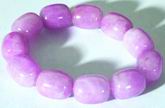
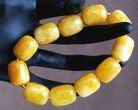

To make a bracelet using elastic, to go with a necklace, only take a few
minutes and is a great way to use up the few extra beads left over. Arrange the
beads to form a 7 inch long bracelet as standard. Once you have your beads
arranged take your spool of elastic and string the beads without cutting a
length of elastic. This will keep your beads in place. To finish, a larger
complementary bead for the end looks attractive. Pull both ends of the elastic
through this bead, and then pull both ends through a small crimp bead. Then
flatten the crimp bead with pliers to secure the beads.
History of Jade
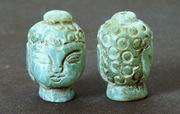


For 5,000 years Imperial China used the word "jade" as something
precious - as in English we use gold. †Because the Chinese believe jade has all the
attributes most valued in society. A symbol of purity and serenity, it is
delicate, but will not break - is beautiful, but not impermanent, it can be
flawed with lines, but still pleasing. It is believed to radiate divine
unconditional love and balance the emotions. Held in the hand it can
improve judgment - ancient silk traders often held jade while bartering.
A small piece of jade worn around the neck was said to dispel illness.
Chinese jade first arrived in the West during the
sixteenth century, brought from
Jade was thought to preserve the body after death and can be
found in emperors' tombs from thousands of years ago. One tomb contained an
entire suit made out of jade, to assure the physical immortality of its owner. †Jadeite is also thought to cure kidney stones
and other kidney ailments.
Types of Jade


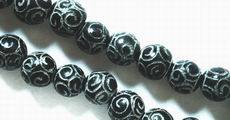

The most famous type of jade carved in
Jade is remarkably tough, used by many early civilizations for axes, knives and weapons.† Because of its smooth even texture, jade was soon carved into ornaments - and it wasn't until 1863 that it was realized that Jade was being applied to two different minerals: jadeite and nephrite.† Jadeite is almost never found in individual crystals and is composed of microscopic interlocking crystals that produce a very tough material. The nephrite variety is composed of fibrous crystals inter-twinned in a tough compact mass.† Nephrite is more abundant than jadeite and has fewer color varieties - usually less intense dark spinach greens, white, browns, and black.
Where Does Jade Come From?


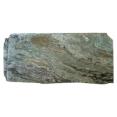

Most jadeite today is mined in
Quality of Jade

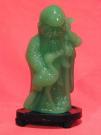

Jade is most often sold by the piece rather than per carat.
Although the overall color is the most important value factor, attention is
also paid to translucency, texture, and also to pattern. Certain patterns,
including moss in snow, are highly valued. Both jadeite and nephrite are very
durable and tough, although jadeite is slightly harder than nephrite due to its
microcrystalline structure.
The top jadeite jade is usually cut into smooth dome shapes called cabochons. Jadeite bangles are also very popular in Asian countries. Beads are also very beautiful and some important jadeite necklaces made during the art deco period have fetched hundreds of thousands of dollars in auctions in the past few years.
Special Offer Worth 10% Off !
To sample our beads with 10% off
in our MrBead bead store, just key in "lovejade" at the checkout (without the
inverted commas) and click "Redeem Coupon". The more you
spend - the more you save!
Offer valid until the end of May only - so act now! Only for use in our store at the checkout and not valid with any other offers. To go to the store click here
To see our loose jade beads click
here
To see our strand jade beads click
here
To see our jade necklaces click
here
To see our jade rings click
here
Too see our jade bracelets click
here
To see our store front, click MrBead.com
|
|
|
|
|
|
|
Subscribe Unsubscribe |
|
To return to the top of page click here